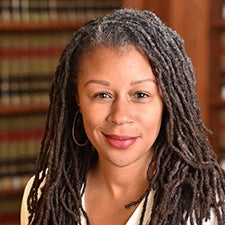To Pod or Not to Pod
UCLA Law Magazine | Fall 2020 | Volume 43
 LATOYA BALDWIN CLARK is an assistant professor of law and core member of the CRS faculty who writes and teaches about education law, family law, property law and race and discrimination. Her articles include “Education as Property” in the Virginia Law Review and “Stealing Education,” to be published in the UCLA Law Review, which shows how public-school stakeholders use master racial stereotypes to justify educational exclusion using the rhetoric of property rights. She joined the UCLA Law faculty in 2018 and runs the popular Doctor Mama Esquire blog.
LATOYA BALDWIN CLARK is an assistant professor of law and core member of the CRS faculty who writes and teaches about education law, family law, property law and race and discrimination. Her articles include “Education as Property” in the Virginia Law Review and “Stealing Education,” to be published in the UCLA Law Review, which shows how public-school stakeholders use master racial stereotypes to justify educational exclusion using the rhetoric of property rights. She joined the UCLA Law faculty in 2018 and runs the popular Doctor Mama Esquire blog.
In this unprecedented time of COVID-19, caretakers of all colors, genders and class face a formidable task: how to work while engaging in full-time childcare. I spent this summer reflecting on how glorious it would be to experience the “most wonderful time of the year” – the day my children returned to school after five months “off.” Yet as the summer progressed, I realized that that day would likely not come this calendar year. Instead, “back to school” would mean back to waking my children up early without the relief of watching them leave the house.
In response to this disappointing event, many parents have created learning “pods,” cooperatives that involve two or more families pooling their resources to hire a teacher or other adult to supervise their children doing school from home. The pandemic presses parents on all sides, and pods solve a problem that the school district is ill-equipped to do – adequately support individual children in school at home who have working parents that cannot provide the attention needed. But pod critics note that pods inherently stratify by race and class – parents with means create personalized experiences for their children, even more than they would receive at school. These experiential differences exacerbate existing chasms.
Parents’ anxieties about their ability to manage both work and school and worries about their children’s academic progress strongly affect the choice to participate in a pod. But the question of whether to “pod” or not is not really the important question. For pods expose a deeper concern: How can one be “for” public education yet make decisions that, in the aggregate, cut against the very nature of education for the public’s good? This is a key question I ask in my research. Many parents committed to the public education endeavor often feel this way often: stuck between wanting what’s “best” for their family and children and what’s “best” for investment in public education.
While pods may be a good option for those who can afford it, they create injustice. Many pods stay enrolled in their school district, taking advantage of the public school curriculum while paying a supervising teacher likely far less than they would a unionized teacher. This teacher does more than simply supervise virtual learning; they also provide one-on-one tutoring and enrichment that schools can only hint at in the distance environment – gym, art and music. For non-podded students and those without a parent actively present during the school day (especially for younger children), teachers inadequately trained on new technology support these students only through a screen. As a result, pods create “opportunity gaps”; children not in pods miss out on these education-enhancing opportunities, and access provides a competitive advantage to those in a position to receive them.
Supporters might say that pods give teachers more time to work with students by reducing the number of children doing distance learning alone. Yet even that exacerbates another problem – systemic segregation. Admittedly, while schools themselves tend to be segregated both between districts and within districts, pods encourage even more homogeneity. Parents tend to befriend other parents who are like them in age, race, gender and even profession. The pod “teacher” will be hand-chosen to fit the parents’ preferences. This differs from what we should expect from public schools, where children learn in heterogeneous classrooms, and school leadership chooses the teacher, not individual parents.
In a utopian vision of public school, communities make decisions to maximize what’s best for all children in the community, not to maximize what’s best for any particular child. Pods, because they give children opportunities unavailable to those not in pods and because they promote homogeneity, are antithetical to the public school mission. To pod or not to pod implicates our commitments to public education, a project that requires schools to educate children from heterogenous backgrounds together and equally for societal participation.
As a parent myself with the means to join a pod, I understand the urge to do so, both for my sanity and that of my children. But we are a part of the collective whole that has the potential to push for a truly public education, i.e., education for the public’s good, for the good of democracy, for the good of equality. This means I must look beyond the comfort of myself and my children, commit to sharing in the burdens of a global pandemic, and work with others to meet its demands.